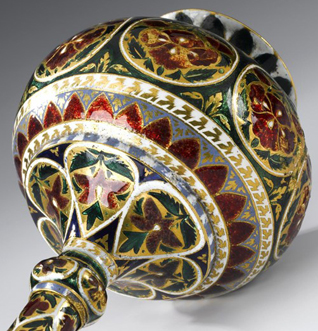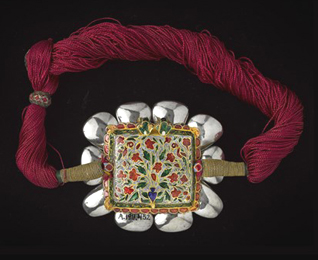Art
The Jewellery Of The Last Sikh Emperor:
Maharaja Duleep Singh
NATIONAL MUSEUM OF SCOTLAND
Ornate and intricately detailed, this collection of jewellery and personal possessions once belonged to the last Emperor of Punjab, Maharaja Duleep Singh.
The objects were later purchased by Major Donald Lindsay Carnegie and bequeathed to the National Museum of Scotland upon his death in 1911.
FACT FILE
Date: Late 18th to mid 19th centuries
Made in: Punjab, et al
Acquired in: 1911
On display: Indian Encounters, Special Exhibition Gallery 2, Level 3, National Museum of Scotland
Museum references: Ear ornament A.1911.467, nose ring pendant A.1911.470, square pendant A.1911.471, gilded silver pendant A.1911.472, bracelets A.1911.453-5, betel box A.1911.464, pen case A.1911.473
Maharaja Duleep Singh was born in 1838 in Lahore, the capital of the Sikh Empire. As a young boy, Duleep Singh became the Sikh Emperor but his reign was short lived. In 1849, the East India Company deposed him, confiscated the majority of the Sikh treasury, and placed him under the guardianship of the Scotsman Sir John Login.
At the age of fifteen, while under British custody and isolated from his family, court and co-relgionists for several years by now, Duleep converted to Christianity and moved to Britain where he lived as a British aristocrat. He lived for some years on a number of different in estates in Scotland, including at Castle Menzies in Perthshire.
CARNEGIE
Donald Lindsay Carnegie, born in 1840, enlisted into the military in 1858. By 1876, he rose to the rank of Major and served the latter part of his career in India until his retirement, in around 1877, when he moved to St. Andrews, Scotland.
In 1899, Prince Victor Duleep Singh, the Maharaja's eldest son, sold part of his inheritance in order to pay off his considerable debts -- accumulated because the British Government had reneged on its treaties and had usurped all of Duleep Singh’s estate long before his death.
Carnegie, mainly a collector of coins, later purchased a number of these items from the auction house Spink's, a decision possibly inspired by his years of service in India.
Upon his death in 1911, Major Carnegie bequeathed his collection to the National Museum of Scotland.
THE EMPEROR’S PEN CASE
This piece, part of Carnegie's collection, is a detailed gold pen case produced in Punjab during the nineteenth century.
In order to create the flowers and leafy scrolls covering the surface of the case, the artist employed a technique known as 'chasing' in which the metal is pushed back to reveal the designs. As gold was considered precious, this technique was chosen in order to preserve as much of the metal as possible. The circular opening at the top of the inner case is an ink well used to hold the ink for writing.
As interpreted by the British artists, the Singh Twins -- Rabindra and Amrit Kaur Singh -- in their painting ‘Casualty of War: A Portrait of Maharaja Duleep Singh,’ this pen case might have held the brushes and ink Duleep Singh used to write to the British government, demanding that he be reinstated as ruler of Punjab.
After the appeal was ignored, Duleep Singh reconverted to Sikhism and travelled to Europe in the hopes of rallying support for his cause. However, in 1893 he died, having been denied entry into the subcontinent and thereafter having fled the British Isles in disgust, to live in self-exile in a hotel in Paris, France.
Edited for sikhchic.com
February 1, 2015
Conversation about this article
1: Basant Kaur (Liverpool, United Kingdom), February 01, 2015, 10:31 AM.
Duleep Singh's jewellery included, of course, the world's most famous jewel -- the Kohinoor -- which was promptly 'taken' by Lord Dalhousie, through the auspices of his protege, his fellow Scotsman, John Login, soon after the child Duleep was taken prisoner and separated from his mother and family. Dalhousie, in order to ingratiate himself to Queen Victoria and the British Government, and to encourage them to turn a blind eye to the shiploads of loot he had plundered from the Sikhs and quietly whisked away to his own manors in Scotland, presented the Kohinoor to her ... and proclaimed to the world years later, in typical British fashion, that it had been 'gifted' to her by Duleep Singh himself! Such a classy people, these English and Scots!






